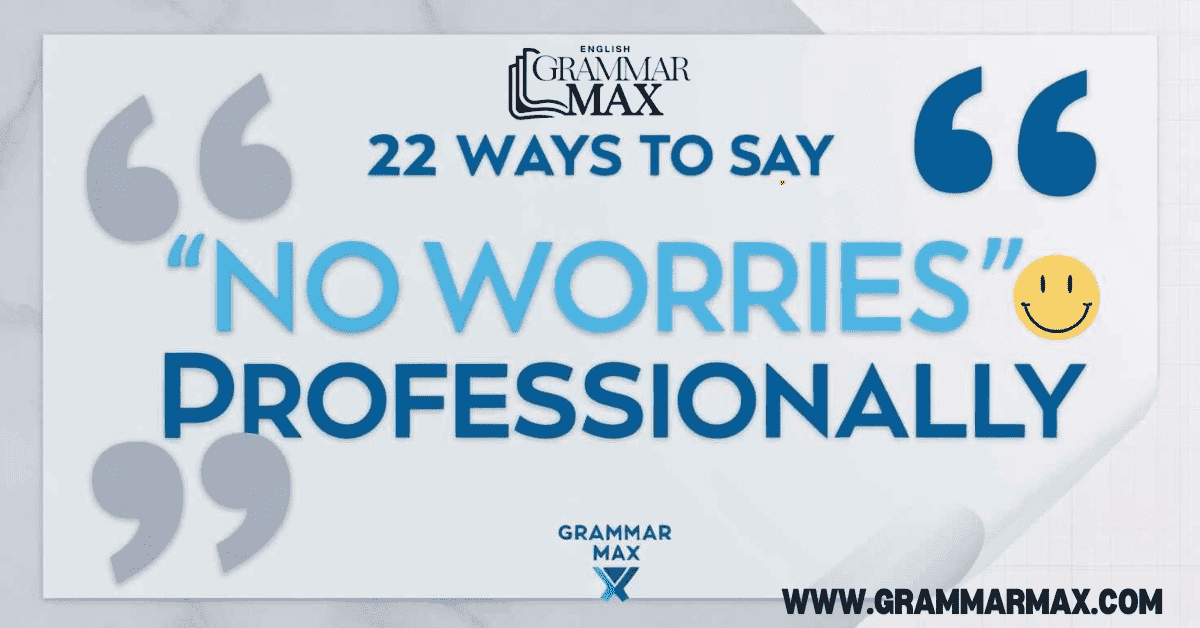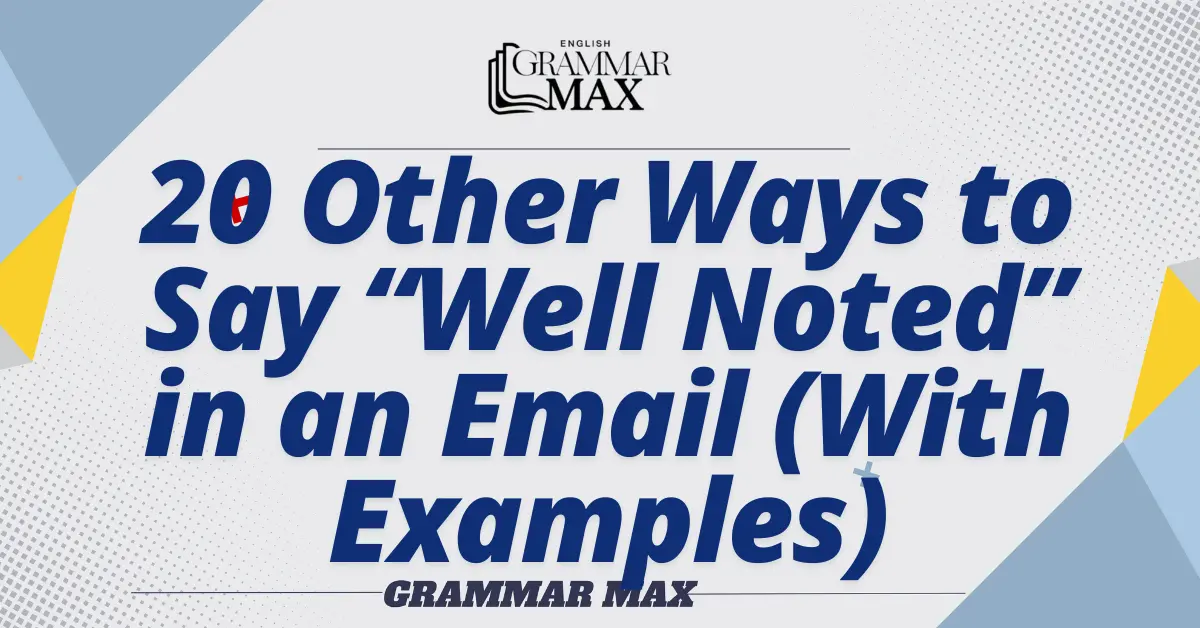In professional communication, it’s essential to respond with language that is both courteous and clear. Whether you’re replying to a colleague’s apology or reassuring someone that a mistake is not a big deal, “No worries” can be a useful and informal phrase. However, in a workplace setting, it may be necessary to find more formal alternatives. Below are 22 professional ways to say “No worries”, including best use cases and scenario examples for each.
Alternative ways to say “No Worries”

Here’s a comprehensive 22 ways to say “No Worries” professionally:
- Absolutely Fine
- No Harm Done
- Don’t Give It Another Thought
- I Understand, No Problem at All
- Not to Worry
- All Is Well
- Mistakes Happen, It’s Okay
- No Issue on My End
- I Appreciate Your Concern
- Let’s Put That Behind Us
- It’s All Water Under the Bridge
- No Worries at All
- Professional Response
- Not a Problem
- It’s Absolutely Fine
- That’s Completely Understandable
- Feel Free to Ignore It
- It Doesn’t Affect Us
- Everything’s Under Control
- No Need to Apologize
- It’s All Good
- Understood and Accepted
1. Absolutely Fine
One of the most professional alternatives to “No worries” is “Absolutely fine”. This phrase conveys a sense of calm and reassurance, making it perfect for work environments.
Best use case: When a colleague apologizes for a minor error or inconvenience.
Example (in an email):
Hi Sarah,
I noticed the delay in receiving the report, but it’s absolutely fine. Let me know if you need any support.
Regards,
Mark
2. No Harm Done
“No harm done” is a professional way to let someone know their mistake didn’t cause any significant damage or inconvenience.
Best use case: When someone corrects a small mistake before it escalates.
Example (in a conversation):
Colleague: I accidentally included the wrong attachment, but I sent the correct one now.
You: No harm done, I’ve got the correct one now.
3. Don’t Give It Another Thought
To assure someone that an issue isn’t worth worrying about, you can use “Don’t give it another thought”. This phrase adds a polite tone to your reassurance.
Best use case: When someone feels guilty about a small oversight.
Example (in a meeting):
Team Member: I’m really sorry I didn’t send that file earlier.
You: Don’t give it another thought; we’ll still be able to meet the deadline.
4. I Understand, No Problem at All
By saying “I understand, no problem at all”, you’re letting the other person know that their actions are acceptable and nothing to worry about.
Best use case: When dealing with a justified delay or mistake.
Example (in an email):
Hi John,
I see that the shipment was delayed due to unforeseen circumstances. I understand, no problem at all. We can reschedule the meeting to next week.
Best,
Anna
5. Not to Worry
Another way to say “No worries” professionally is “Not to worry”. This phrase is concise, polite, and effective for workplace communication.
Best use case: For casual, yet professional communication with colleagues.
Example (over chat):
Colleague: I’m sorry I missed the meeting today.
You: Not to worry, I’ll send you a quick recap.
6. All Is Well
Using “All is well” brings a sense of calm and resolution to your response, ensuring the other party feels reassured.
Best use case: When someone feels overly apologetic for a small issue.
Example (in an email):
Hi Rachel,
I noticed the mix-up in your presentation, but all is well now. You handled the situation perfectly.
Regards,
Tom
7. Mistakes Happen, It’s Okay
When you want to encourage a colleague while minimizing the impact of their mistake, you can use “Mistakes happen, it’s okay”. It’s an empathetic way to convey understanding.
Best use case: In scenarios where a team member is upset about a mistake.
Example (during a project review):
Team Member: I apologize for the delay, I miscalculated the timeline.
You: Mistakes happen, it’s okay. Let’s adjust the schedule and move forward.
8. No Issue on My End
If you want to clarify that a situation didn’t cause any problems for you personally, you can say “No issue on my end”. It’s a direct and professional response.
Best use case: When confirming that a situation didn’t affect your work.
Example (in a reply email):
Hi Alex,
No worries about the late reply. No issue on my end, the project is still on track.
Best,
Michael
9. I Appreciate Your Concern
Acknowledging someone’s effort to address a mistake while reassuring them is key in professional settings. “I appreciate your concern” strikes the perfect balance between gratitude and reassurance.
Best use case: When a colleague over-apologizes for a minor issue.
Example (in a conversation):
Colleague: I’m really sorry about the error in the budget report.
You: I appreciate your concern, but it didn’t affect the overall outcome.
10. Let’s Put That Behind Us
When you want to move forward from an issue, “Let’s put that behind us” is a great way to signal that you’re ready to proceed without dwelling on past mistakes.
Best use case: After resolving a miscommunication or issue.
Example (in an email):
Hi George,
Thanks for clarifying the misunderstanding earlier. Let’s put that behind us and focus on the upcoming project.
Regards,
Jessica
11. It’s All Water Under the Bridge
This phrase, “It’s all water under the bridge”, is a metaphorical way of saying that the issue is in the past and forgotten. It’s perfect for encouraging forward-thinking in professional settings.
Best use case: After resolving an old issue that no longer has consequences.
Example (in a chat):
Colleague: I apologize for that mix-up a few weeks ago.
You: It’s all water under the bridge, no need to revisit it.
12. No Worries at All
A variation of the original phrase, “No worries at all” can be used professionally when a more relaxed tone is appropriate. It conveys reassurance without sounding too informal.
Best use case: In internal communications between colleagues.
Example (in an email):
Hi Emily,
There’s no rush on the updated designs. No worries at all, take your time.
Best,
Chris
13. Professional Response
If you need a slightly more formal version, you can offer a professional response that emphasizes understanding and professionalism.
Best use case: When responding to client feedback or apologies.
Example (in an email to a client):
Dear Mr. Johnson,
Thank you for the update. I completely understand the delay. Rest assured, there is no issue on my end.
Best regards,
Stephanie
14. No Worries Synonym: Not a Problem
“Not a problem” is another way to say “No worries” and is one of the most common phrases used in professional settings.
Best use case: When downplaying a minor issue.
Example (in a conversation):
Colleague: I’m sorry for submitting the wrong report.
You: Not a problem, I’ve updated it on my end.
15. No Worries Meaning: It’s Absolutely Fine
Sometimes, when something minor happens, you want to assure the other person that everything is under control. By saying “It’s absolutely fine”, you can calm their concerns effectively.
Best use case: When reassuring a client or team member.
Example (in an email):
Hi Oliver,
I noticed the error in the document you sent over. It’s absolutely fine though—I’ve made the correction on my end.
Best regards,
Laura
16. That’s Completely Understandable
Expressing understanding is a key component of professional communication. “That’s completely understandable” conveys empathy and acceptance without being overly casual.
Best use case: When a colleague explains a legitimate reason for a delay or mistake.
Example (in an email):
Hi Daniel,
I understand that the recent changes have caused some delays. That’s completely understandable. Let’s discuss how we can move forward effectively.
Best regards,
Megan
17. Feel Free to Ignore It
Sometimes, the best way to alleviate someone’s concerns is to give them permission to move on. “Feel free to ignore it” provides a clear and professional way to do so.
Best use case: When addressing a minor issue that doesn’t require further attention.
Example (in a meeting):
Team Member: I’m sorry for the confusion in the last email.
You: Feel free to ignore it, and let’s focus on the main agenda today.
18. It Doesn’t Affect Us
This phrase clearly communicates that the issue at hand has no impact on your work or the overall project. “It doesn’t affect us” is a straightforward and professional response.
Best use case: When a minor problem is brought to your attention that doesn’t have wider implications.
Example (in a conversation):
Colleague: I accidentally booked the meeting room for the wrong time.
You: It doesn’t affect us, we can easily reschedule.
19. Everything’s Under Control
Reassuring someone that you have the situation handled can be very comforting. “Everything’s under control” conveys confidence and professionalism.
Best use case: When a mistake is made, but you have already taken steps to rectify it.
Example (in an email):
Hi Team,
There was a minor glitch in the system earlier, but everything’s under control now. We’re back on track.
Best,
Laura
20. No Need to Apologize
Sometimes, simply telling someone that an apology isn’t necessary can effectively convey that there are no hard feelings. “No need to apologize” is a polite and professional way to do this.
Best use case: When someone apologizes excessively for a trivial matter.
Example (in a conversation):
Colleague: I’m so sorry for being late to the meeting.
You: No need to apologize, we’ve already started and it’s going well.
21. It’s All Good
“It’s all good” is a modern and friendly way to reassure someone, yet it remains professional enough for many workplace settings.
Best use case: In less formal communications where a friendly tone is appropriate.
Example (in a chat message):
Colleague: I forgot to attach the file in my previous email.
You: It’s all good, I can access it from the shared drive.
22. Understood and Accepted
This phrase emphasizes that you have comprehended the situation and are okay with it. “Understood and accepted” is both clear and professional.
Best use case: When confirming receipt of information that may have been delayed or altered.
Example (in an email):
Hi Emma,
I received the updated schedule. Understood and accepted. Let’s proceed as planned.
Best,
Robert
Is it Professionally to Say “No Worries”

Saying “No Worries” can be perceived as informal and may not always convey the level of professionalism desired in workplace communication. While it expresses a casual reassurance, opting for more formal phrases, such as “I understand, no problem at all” or “not to worry,” can enhance the tone of your response. It’s essential to consider the context and the relationship with the recipient. In more formal settings, using alternatives can demonstrate respect and ensure clarity, making your communication more effective and appropriate.
Frequently Asked Question
What is another way to say “no worries”?
You can say “no problem” or “it’s all good” as alternatives to “no worries.”
How to professionally say “no worries”?
A professional way to say “no worries” is “I appreciate your concern” or “not to worry.”
How do you formally say not to worry?
Formally, you can say “please don’t be concerned” or “there’s no need for concern.”
How to stop saying “no worries” if not?
Instead of “no worries,” use phrases like “that’s perfectly understandable” or “I completely understand.”
Conclusion
In conclusion, while “No Worries” can offer a casual reassurance, it’s vital to choose more professional alternatives in workplace communication. The phrases listed, from “Absolutely Fine” to “Understood and Accepted,” not only convey understanding but also enhance the tone of your interactions. By employing these professional expressions, you maintain a positive atmosphere and demonstrate respect for your colleagues’ concerns. Ultimately, selecting the right language ensures your communication remains both clear and constructive, fostering a supportive and professional environment.

William Henry is a writer for Grammar Max, a blog that focuses on synonyms and phrases. He loves exploring the quirks of the English language and enjoys helping readers improve their vocabulary. William’s articles are easy to read, fun, and full of useful tips for anyone looking to better understand and use English. Whether you’re a student, a professional, or just someone interested in language, William’s writing on Grammar Max makes learning about words and their meanings simple and enjoyable.





